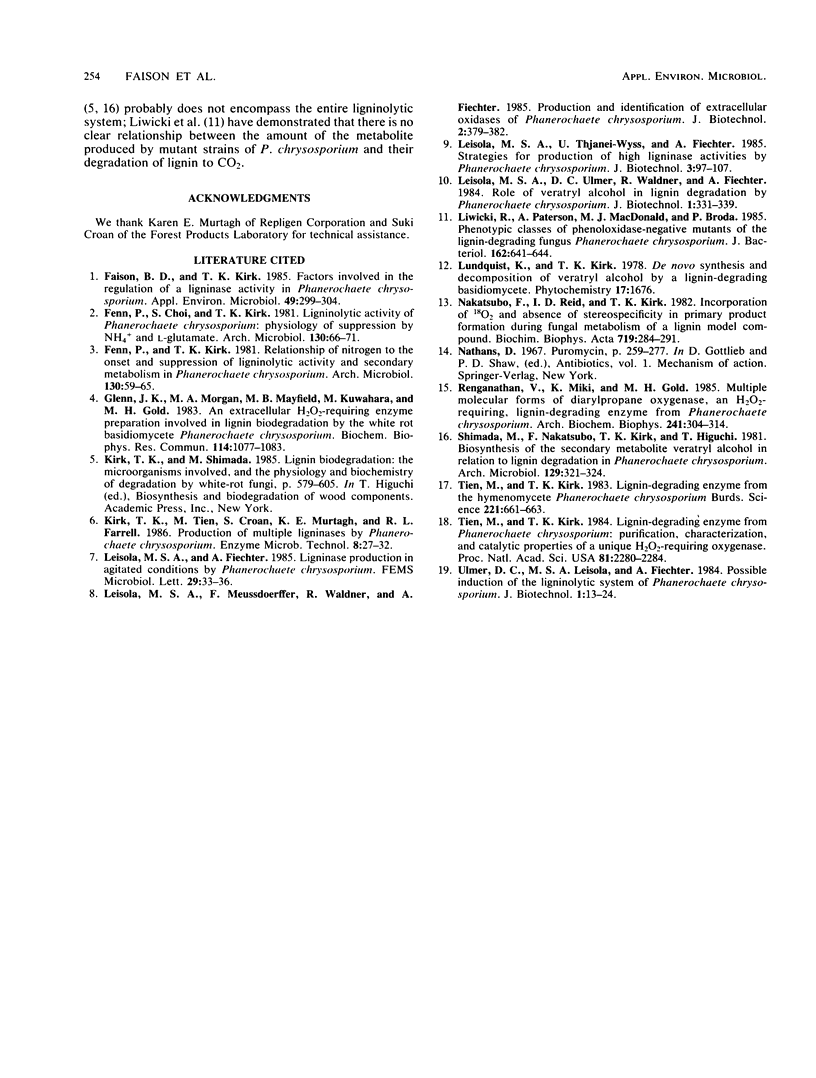Abstract
Ligninase activity in Phanerochaete chrysosporium is stimulated by incubating cultures with various substrates for the enzyme, including veratryl (3,4-dimethoxybenzyl) alcohol, which is a secondary metabolite of this fungus. This study was designed to provide insight into the mechanism involved in this stimulation. Ligninase activity increased 2 to 4 h after the addition of exogenous veratryl alcohol to ligninolytic cultures. This increase was prevented by inhibitors of protein synthesis. Analysis of the extracellular proteins by high-performance anion-exchange liquid chromatography revealed increases in the amounts of some, but not all, ligninase species. The normal rapid decrease in ligninase activity in aging cultures was not prevented or retarded by veratryl alcohol, indicating that veratryl alcohol does not increase ligninase activity by protecting extant enzyme. We conclude that veratryl alcohol probably functions via an induction type of mechanism, affecting only certain ligninase species. Results with an isolated lignin indicate that lignin (or its biodegradation products) functions in the same way that veratryl alcohol does.
Full text
PDF



Selected References
These references are in PubMed. This may not be the complete list of references from this article.
- Faison B. D., Kirk T. K. Factors Involved in the Regulation of a Ligninase Activity in Phanerochaete chrysosporium. Appl Environ Microbiol. 1985 Feb;49(2):299–304. doi: 10.1128/aem.49.2.299-304.1985. [DOI] [PMC free article] [PubMed] [Google Scholar]
- Glenn J. K., Morgan M. A., Mayfield M. B., Kuwahara M., Gold M. H. An extracellular H2O2-requiring enzyme preparation involved in lignin biodegradation by the white rot basidiomycete Phanerochaete chrysosporium. Biochem Biophys Res Commun. 1983 Aug 12;114(3):1077–1083. doi: 10.1016/0006-291x(83)90672-1. [DOI] [PubMed] [Google Scholar]
- Liwicki R., Paterson A., MacDonald M. J., Broda P. Phenotypic classes of phenoloxidase-negative mutants of the lignin-degrading fungus Phanerochaete chrysosporium. J Bacteriol. 1985 May;162(2):641–644. doi: 10.1128/jb.162.2.641-644.1985. [DOI] [PMC free article] [PubMed] [Google Scholar]
- Renganathan V., Miki K., Gold M. H. Multiple molecular forms of diarylpropane oxygenase, an H2O2-requiring, lignin-degrading enzyme from Phanerochaete chrysosporium. Arch Biochem Biophys. 1985 Aug 15;241(1):304–314. doi: 10.1016/0003-9861(85)90387-x. [DOI] [PubMed] [Google Scholar]
- Tien M., Kirk T. K. Lignin-Degrading Enzyme from the Hymenomycete Phanerochaete chrysosporium Burds. Science. 1983 Aug 12;221(4611):661–663. doi: 10.1126/science.221.4611.661. [DOI] [PubMed] [Google Scholar]
- Tien M., Kirk T. K. Lignin-degrading enzyme from Phanerochaete chrysosporium: Purification, characterization, and catalytic properties of a unique H(2)O(2)-requiring oxygenase. Proc Natl Acad Sci U S A. 1984 Apr;81(8):2280–2284. doi: 10.1073/pnas.81.8.2280. [DOI] [PMC free article] [PubMed] [Google Scholar]


